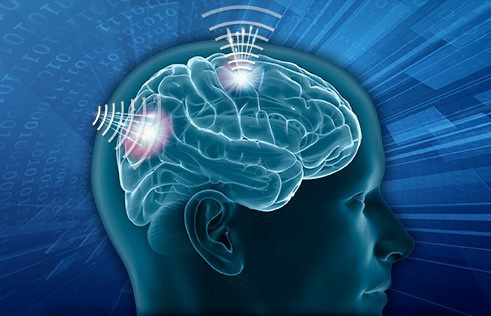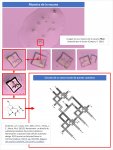And how on earth is an injection to the circulatory system supposed to accomplish this? Even if the hypothetical nanite particles can penetrate the blood-brain barrier, they'll do so at random locations in the brain so pulsing an electrical charge through one to trigger surrounding neurons will have random effects. That's not mind control, it's a fancy way of inducing seizures. And that's not even getting into the issues of powering the particles or remote-controlling them to activate at specific times. They're too small for long-lasting batteries and wireless broadcasting of control signals or power wouldn't be much use for something with a literally microscopic antenna embedded in a comparatively colossal lump of water made semisolid by impurities of carbon and trace elements.
Three things.
One, the expression of ACE2 in the brain and in the blood-brain barrier is heterogeneous. Different brain regions have more ACE2 expression than others.

The Altered Anatomical Distribution of ACE2 in the Brain With Alzheimer’s Disease Pathology
The whole world is suffering from the coronavirus disease 2019 (COVID-19) pandemic, induced by severe acute respiratory syndrome coronavirus 2 (SARS-CoV-2) through angiotensin-converting enzyme 2 (ACE2). Neurological manifestations in COVID-19 patients suggested the invasion of SARS-CoV-2 into...
In detail, ACE2 was expressed at a high level in the pons, visual cortex, and amygdala, which was relatively reduced in the midbrain, cerebellar cortex, dentate nucleus, and medulla.

ACE2 expression in rat brain: Implications for COVID-19 associated neurological manifestations
We examined cell type-specific expression and distribution of rat brain angiotensin-converting enzyme 2 (ACE2), the receptor for SARS-CoV-2, in the rodent brain. ACE2 is ubiquitously present in brain vasculature, with the highest density of ACE2 expressing ...
Here, we examined cell type-specific expression and regional distribution of ACE2 in the rodent brain. We used immunohistochemistry to characterize the pattern of ACE2 expression in vascular, glial, and neuronal elements, participants of several well-defined circuits for respiratory rhythm, arousal, reward, homeostasis, learning, and memory. We analyze and discuss the possible consequences of the disruption of these circuits in contributing to COVID-19 CNS disease.
Two, SARS-CoV-2 Spike, the external structural protein that SARS-CoV-2 uses to infect vascular endothelial cells through their ACE2 enzymes (and also the protein produced as an antigen by the gene transfection "vaccines"), opens up the tight junctions of the blood-brain barrier, and is basically perfect for delivering nanomaterials across the BBB that would otherwise be blocked.

The SARS-CoV-2 spike protein alters barrier function in 2D static and 3D microfluidic in-vitro models of the human blood–brain barrier
As researchers across the globe have focused their attention on understanding SARS-CoV-2, the picture that is emerging is that of a virus that has ser…
 www.sciencedirect.com
www.sciencedirect.com
Key to our findings is the demonstration that S1 promotes loss of barrier integrity in an advanced 3D microfluidic model of the human BBB, a platform that more closely resembles the physiological conditions at this CNS interface. Evidence provided suggests that the SARS-CoV-2 spike proteins trigger a pro-inflammatory response on brain endothelial cells that may contribute to an altered state of BBB function.
Three, they are in the process of overcoming all of the technical hurdles involved with wirelessly powering and controlling nanotechnology in someone's body.
This is what Charles Lieber, the buddy of Robert Langer, the co-founder of Moderna, was working on with his DARPA money:
Implementation of complex computer circuits assembled from the bottom up and integrated on the nanometer scale has long been a goal of electronics research. It requires a design and fabrication strategy that can address individual nanometer-scale electronic devices, while enabling large-scale assembly of those devices into highly organized, integrated computational circuits. We describe how such a strategy has led to the design, construction, and demonstration of a nanoelectronic finite-state machine. The system was fabricated using a design-oriented approach enabled by a deterministic, bottom–up assembly process that does not require individual nanowire registration. This methodology allowed construction of the nanoelectronic finite-state machine through modular design using a multitile architecture. Each tile/module consists of two interconnected crossbar nanowire arrays, with each crosspoint consisting of a programmable nanowire transistor node. The nanoelectronic finite-state machine integrates 180 programmable nanowire transistor nodes in three tiles or six total crossbar arrays, and incorporates both sequential and arithmetic logic, with extensive intertile and intratile communication that exhibits rigorous input/output matching. Our system realizes the complete 2-bit logic flow and clocked control over state registration that are required for a finite-state machine or computer. The programmable multitile circuit was also reprogrammed to a functionally distinct 2-bit full adder with 32-set matched and complete logic output. These steps forward and the ability of our unique design-oriented deterministic methodology to yield more extensive multitile systems suggest that proposed general-purpose nanocomputers can be realized in the near future.
Brain Science – Lieber Research Group
Fundamental, cognitive & behavioral neuroscience. Central to fundamental neuroscience are computational principles of neural network, connectivity and plasticity of large-scale neuron ensembles, storage and retrieval of information, and long-term evolution of neural dynamics underlying cognition and behavior. We are carrying out long-term electrophysiological recordings focused on fast single-neuron firing activities, inter-neuronal communications, large-scale brain region orchestration with slow-wave modulation, along with guided migration of neural progenitor cells during neurogenesis in rodent and primate studies of visual perception, motor execution, spatial memory and contextual learning.
This is what DARPA want for soldiers:
TA2 involves the development of a system that includes a nanotransducer placed on or near
neurons of interest and an integrated sensor/stimulator device that sits outside the skin. The
nanotransducer may include technologies such as, but not limited to, self-
assembled/molecular/biomolecular/chemical nanoparticles, or viral vectors. These
nanotransducers must be delivered in a minutely invasive (nonsurgical) manner, which may
include ingestion, injection, or nasal administration, and involve technology that includes self-
assembly inside the body. While the major TA2 goals of developing neural read out and write in
capabilities are similar to the goals from TA1, creating a nanotransducer with an optimal
delivery route to the brain is a major additional component. Another major component of TA2 is
achieving cell-type specificity. Proposers may choose which cell types they plan to target but must justify their decision. Furthermore, due to the proximity of the nanotransducer to the
neuron, the metrics for TA2 are stricter, requiring single neuron spatial resolution and a higher
number of control and sensory signals as outlined in Table 2.
Similar to TA1, TA2 proposals must include a system design description of the technology for
read out and write in. The description should include the technical objectives delineated in TA1
and must provide a detailed description of the proposed nanotransducer. Teams must describe a
viable delivery plan that allows the nanotransducer to be placed into the periphery and obtain
proximity to its intended target in the brain. Proposals must also technically address how neural
interfaces will achieve spatial control and stability. Proposals must describe the intended
efficiency of the transducer (e.g., the percent of recorded neural activity compared to a state-of-
the-art recording method). Proposals must also describe the expected nanotransducer response
properties (e.g., rise, decay, refractory period) that should support program temporal resolution
metrics (Table 2) and capture and/or drive neuronal activity.

Magnetism Plays Key Roles in DARPA Research to Develop Brain-Machine Interface without Surgery - Magnetics Magazine
Some of the most exotic research involving magnetism is sponsored by the U.S. Defense Advanced Research Projects Agency, known as DARPA. One of their programs, literally, boggles the mind as it delves into areas once [...]
 magneticsmag.com
magneticsmag.com
The N3 teams are pursuing a range of approaches that use optics, acoustics and electromagnetics to record neural activity and send signals back to the brain at high speed and resolution. The research is split between two tracks. Teams are pursuing either completely noninvasive interfaces that are entirely external to the body or minutely invasive interface systems that include nanotransducers that can be temporarily and non-surgically delivered to the brain to improve signal resolution.
Noninvasive neurotechnologies such as the electroencephalogram and transcranial direct current stimulation already exist, but do not offer the precision, signal resolution and portability required for advanced applications by people working in real-world settings. The envisioned N3 technology breaks through the limitations of existing technology by delivering an integrated device that does not require surgical implantation but has the precision to read from and write to 16 independent channels within a 16mm3 volume of neural tissue within 50ms.
Each channel is capable of specifically inter-acting with sub-millimeter regions of the brain with a spatial and temporal specificity that is comparable to existing invasive approaches. Individual devices can be combined to provide the ability to interface to multiple points in the brain at once. To enable future non-invasive brain-machine interfaces, N3 researchers are working to develop solutions that address challenges such as the physics of scattering and weakening of signals as they pass through skin, skull, and brain tissue, as well as designing algorithms for decoding and encoding neural signals that are represented by modalities such as light, acoustic, or electromagnetic energy.
And here are a couple articles outlining the difficulties with in-body wireless communications and wireless power transmission:
All of this seems hypothetical, right? Like some far-off supertech that doesn't actually exist?
Well, there's just one little problem.

ORWELL CITY: La Quinta Columna: 5G technology, graphene oxide and neuro-rights
Part of that social nervous system where someone -by means of artificial intelligence, because artificial intelligence is not the one who is going to

ORWELL CITY: Detection of Graphene in COVID-19 vaccines by Micro-Raman Spectroscopy by Dr. Pablo Campra
Official and definitive expert report of the analysis of the mRNA COVID vaccines, performed and explained by Dr. Pablo Campra.

Leading German Chemist Andreas Noack Dies 30 Minutes After Exposing Graphene Oxide, Possibly Assassinated | EUTimes.NET ⚡ Hidden Story ⚡
Dr. Andreas Noack created a video exposing graphene hydroxide as an ingredient of the Covid injections. Very shortly after that video was made and translated
https://www.researchgate.net/publication/260246546_NanoRouter_A_Quantum-dot_Cellular_Automata_Design


People are finding things in these vaccines that are not supposed to be there.
I have Jose Delgado's book.
No one is prepared to reckon with the truth of all of this. These people are monsters.






